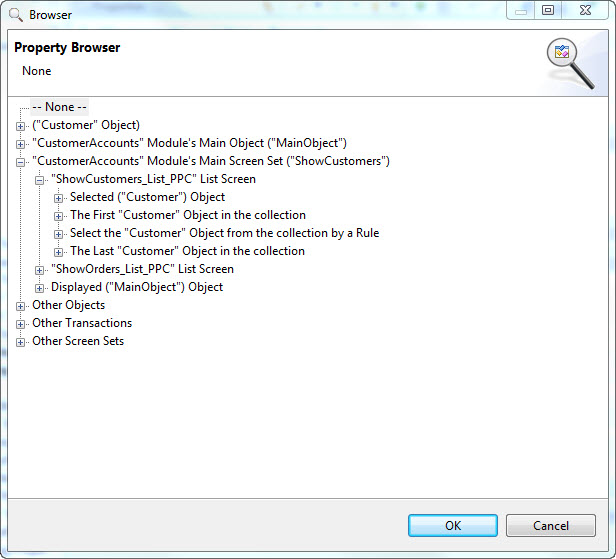The Property Browser provides several options for creating a target path based on the selections made and the values entered or displayed on a screen. In general there are two categories into which these options can be organized: List-related options and Detail Screen Field options. The options available for different list controls are typically the same and, in most cases, the item currently selected in that list is the target path created. For detail screen field options, this is typically related to the value displayed in the field, or in some cases the item represented by the selection made in a field.
Target Path for List Controls
The target path based off of a selection in a list control, which can include the list displayed on a list screen, or the list displayed by one of the detail screen field types that present a list of objects from a collection, will return a property from an object within that list. The collection being displayed can also be accessed directly, though typically this target path is selected via one of the object-related options also presented by the Property Browser.
The following
is a typical list related set of options as presented by the Property
Browser:
In this example the options for a list screen are shown. However, these same options are available for detail screen fields with an edit type of List Tile View and List Selection. All three of these list types display a defined object collection property at run time on the Client, and all three allow the user to make a selection from that list.
- The selected object
- The first object in the collection
- Select the object from collection by rule
- The last object in the collection
Of these options, only the selected object relates specifically to the different list controls. The other three provide the same target paths and behaviors as the options described in the Object-Related Options for target paths and Property Browser.
The Selected Object: Choosing the option of the selected object returns the object currently selected in the list. If the list is defined to allow for multiple selections, then this option provides the same options as when working with a collection property directly. The list of objects selected by the user are treated as a collection, with the instances in that collection being only those selected by the user. Like the options presented for a collection, there are numerous options that can be used to determine which specific object from those selected should be returned, including the first, last, by key field value, and by rule.
